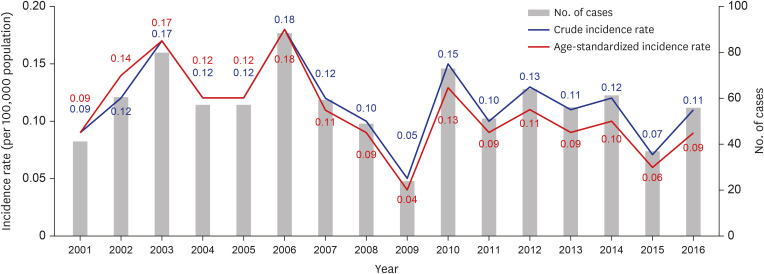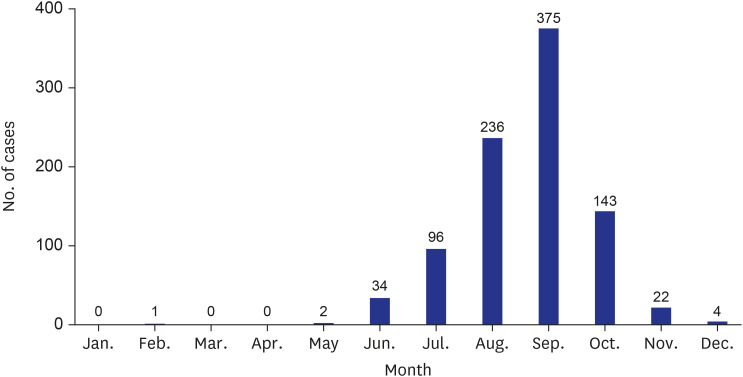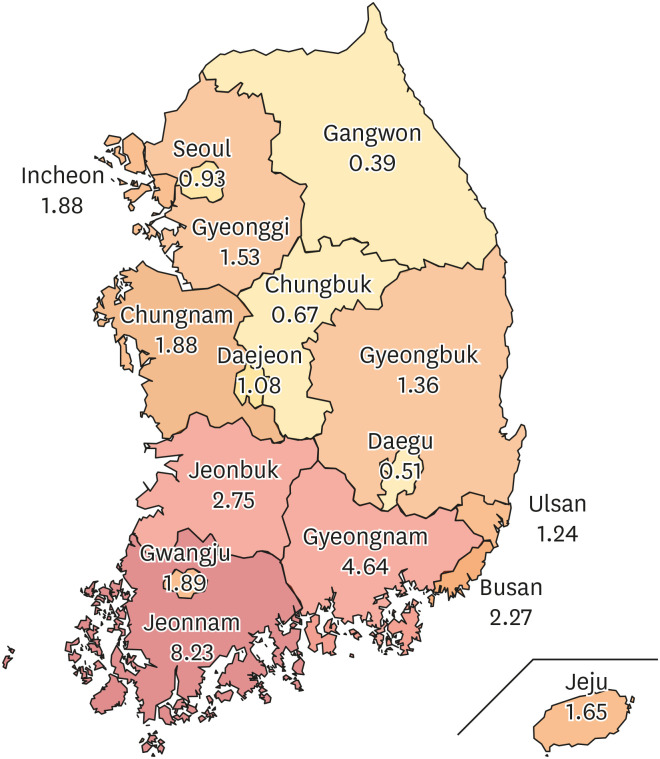J Korean Med Sci.
2022 Mar;37(9):e79. 10.3346/jkms.2022.37.e79.
Epidemiologic Characteristics and Case Fatality Rate of Vibrio vulnificus Infection: Analysis of 761 Cases From 2003 to 2016 in Korea
- Affiliations
-
- 1Korea Disease Control and Prevention Agency, Cheongju, Korea
- 2Department of Preventive Medicine, Korea University College of Medicine, Seoul, Korea
- KMID: 2526972
- DOI: http://doi.org/10.3346/jkms.2022.37.e79
Abstract
- Background
Vibrio vulnificus infection is a highly fatal disease resulting from the consumption of raw or undercooked seafood and exposure to seawater containing the organism. It has been a nationally notifiable disease since 2000 in Korea. The aims of this study were to assess the trends in the incidence of V. vulnificus infection and its case fatality rate and to determine the epidemiologic characteristics to effectively prevent infection and lower mortality.
Methods
We analyzed the incidence trends of V. vulnificus infection by year, month, and region in 913 cases reported to the Korea Centers for Disease Control and Prevention (KCDC, currently Korea Disease Control and Prevention Agency) by the National Infectious Disease Surveillance System from 2001 to 2016. We analyzed the number of patients with V. vulnificus infection who were under the National Health Insurance Service (NHIS) and whose coastal seawater temperature data were provided by the Korea Oceanographic Data Center of the National Institute of Fisheries Science. Epidemiological investigations were followed up and analyzed for 761 patients from 2003 to 2016. A total of 152 patients who were not followed up were excluded from the analysis. The case fatality rate was analyzed for 325 cases reported to the KCDC from 2011 to 2016.
Results
The mean incidence of V. vulnificus infection was 0.12 per 100,000 people, and the highest incidence was reported in September (41.1%) during the study period. The incidence rate per 100,000 people was the highest in Jeonnam (8.23). The number of patients who claimed to the NHIS was the highest in September (105 patients). The average seawater temperature was the highest at 24.1°C in August, and the average seawater temperature from August to October, when many cases occurred, was 22.4°C. The male-to-female ratio was 6:1, and 96.4% of the patients were aged ≥ 40 years. Of the patients, 96.1% had underlying diseases, the most common of which was liver cirrhosis (56.3%). The case fatality rate was 48.9%.
Conclusion
The occurrence of V. vulnificus infection showed distinct seasonality, with a large number of cases occurring in the months when the seawater temperature was high; there were also distinct geographical characteristics. The incidence of V. vulnificus infection and mortality rates have not decreased for decades, and it is still an important public health problem with a high fatality rate.
Figure
Reference
-
1. Yun NR, Kim DM. Vibrio vulnificus infection: a persistent threat to public health. Korean J Intern Med (Korean Assoc Intern Med). 2018; 33(6):1070–1078.2. Baker-Austin C, Oliver JD, Alam M, Ali A, Waldor MK, Qadri F, et al. Vibrio spp. infections. Nat Rev Dis Primers. 2018; 4(1):8. PMID: 30002421.3. Baker-Austin C, Oliver JD. Vibrio vulnificus. Trends Microbiol. 2020; 28(1):81–82. PMID: 31519331.
Article4. Park J, Lee CS. Vibrio vulnificus infection. N Engl J Med. 2018; 379(4):375. PMID: 30044934.5. Oliver JD. The biology of Vibrio vulnificus . Microbiol Spectr. 2015; 3(3):6. Daniels NA. Vibrio vulnificus oysters: pearls and perils. Clin Infect Dis. 2011; 52(6):788–792. PMID: 21367733.7. Baker-Austin C, Oliver JD. Vibrio vulnificus: new insights into a deadly opportunistic pathogen. Environ Microbiol. 2018; 20(2):423–430. PMID: 29027375.
Article8. Patel VJ, Gardner E, Burton CS. Vibrio vulnificus septicemia and leg ulcer. J Am Acad Dermatol. 2002; 46(5):Suppl. S144–S145. PMID: 12004295.9. Strom MS, Paranjpye RN. Epidemiology and pathogenesis of Vibrio vulnificus . Microbes Infect. 2000; 2(2):177–188. PMID: 10742690.10. Leng F, Lin S, Wu W, Zhang J, Song J, Zhong M. Epidemiology, pathogenetic mechanism, clinical characteristics, and treatment of Vibrio vulnificus infection: a case report and literature review. Eur J Clin Microbiol Infect Dis. 2019; 38(11):1999–2004. PMID: 31325061.
Article11. Heng SP, Letchumanan V, Deng CY, Ab Mutalib NS, Khan TM, Chuah LH, et al. Vibrio vulnificus: an environmental and clinical burden. Front Microbiol. 2017; 8:997. PMID: 28620366.12. Yun NR, Kim DM, Lee J, Han MA. pH level as a marker for predicting death among patients with Vibrio vulnificus infection, South Korea, 2000–2011. Emerg Infect Dis. 2015; 21(2):259–264. PMID: 25627847.
Article13. Lee SH, Chung BH, Lee WC. Retrospective analysis of epidemiological aspects of Vibrio vulnificus infections in Korea in 2001–2010. Jpn J Infect Dis. 2013; 66(4):331–333. PMID: 23883847.
Article14. Korea Centers for Disease Control & Prevention. Case Definitions for National Notifiable Infectious Diseases, 2019. Cheongju, Korea: Korea Centers for Disease Control & Prevention;2020.15. Weis KE, Hammond RM, Hutchinson R, Blackmore CG. Vibrio illness in Florida, 1998–2007. Epidemiol Infect. 2011; 139(4):591–598. PMID: 20546636.16. Inoue Y, Ono T, Matsui T, Miyasaka J, Kinoshita Y, Ihn H. Epidemiological survey of Vibrio vulnificus infection in Japan between 1999 and 2003. J Dermatol. 2008; 35(3):129–139. PMID: 18346255.
Article17. Hsueh PR, Lin CY, Tang HJ, Lee HC, Liu JW, Liu YC, et al. Vibrio vulnificus in Taiwan. Emerg Infect Dis. 2004; 10(8):1363–1368. PMID: 15496235.18. Horseman MA, Surani S. A comprehensive review of Vibrio vulnificus: an important cause of severe sepsis and skin and soft-tissue infection. Int J Infect Dis. 2011; 15(3):e157–e166. PMID: 21177133.19. Matsumoto K, Ohshige K, Fujita N, Tomita Y, Mitsumizo S, Nakashima M, et al. Clinical features of Vibrio vulnificus infections in the coastal areas of the Ariake Sea, Japan. J Infect Chemother. 2010; 16(4):272–279. PMID: 20229050.
Article20. Di DY, Lee A, Jang J, Han D, Hur HG. Season-specific occurrence of potentially pathogenic Vibrio spp. on the Southern Coast of South Korea. Appl Environ Microbiol. 2017; 83(3):e02680-16. PMID: 27836844.
Article21. Kim J, Chun BC. Effect of seawater temperature increase on the occurrence of coastal Vibrio vulnificus Cases: Korean national surveillance data from 2003 to 2016. Int J Environ Res Public Health. 2021; 18(9):4439. PMID: 33922061.
Article22. Centers for Disease Control and Prevention (CDC). Vibrio vulnificus infections associated with raw oyster consumption--Florida, 1981–1992. MMWR Morb Mortal Wkly Rep. 1993; 42(21):405–407. PMID: 8497241.23. Dechet AM, Yu PA, Koram N, Painter J. Nonfoodborne Vibrio infections: an important cause of morbidity and mortality in the United States, 1997–2006. Clin Infect Dis. 2008; 46(7):970–976. PMID: 18444811.
Article24. Shapiro RL, Altekruse S, Hutwagner L, Bishop R, Hammond R, Wilson S, et al. The role of Gulf Coast oysters harvested in warmer months in Vibrio vulnificus infections in the United States, 1988–1996. J Infect Dis. 1998; 178(3):752–759. PMID: 9728544.
Article25. Newton A, Kendall M, Vugia DJ, Henao OL, Mahon BE. Increasing rates of vibriosis in the United States, 1996–2010: review of surveillance data from 2 systems. Clin Infect Dis. 2012; 54(Suppl 5):S391–S395. PMID: 22572659.
Article26. Kang SJ, Jung SI, Peck KR. Historical and clinical perspective of Vibrio vulnificus infections in Korea. Infect Chemother. 2020; 52(2):245–251. PMID: 32468743.
Article27. Klontz KC, Lieb S, Schreiber M, Janowski HT, Baldy LM, Gunn RA. Syndromes of Vibrio vulnificus infections. Clinical and epidemiologic features in Florida cases, 1981–1987. Ann Intern Med. 1988; 109(4):318–323. PMID: 3260760.
- Full Text Links
- Actions
-
Cited
- CITED
-
- Close
- Share
- Similar articles
-
- Generalized Erythema Multiforme-like Eruption is the Novel Cutaneous Manifestation of Vibrio Vulnificus Septicemia
- Clinical characteristics of vibrio vulnificus infection
- Biological characteristics and serovars of vibrio vulnificus
- Characteristics of protease produced by vibrio vulnificus and its effect on the activity of hemolysin
- Vibrio vulnificus infection: a persistent threat to public health




